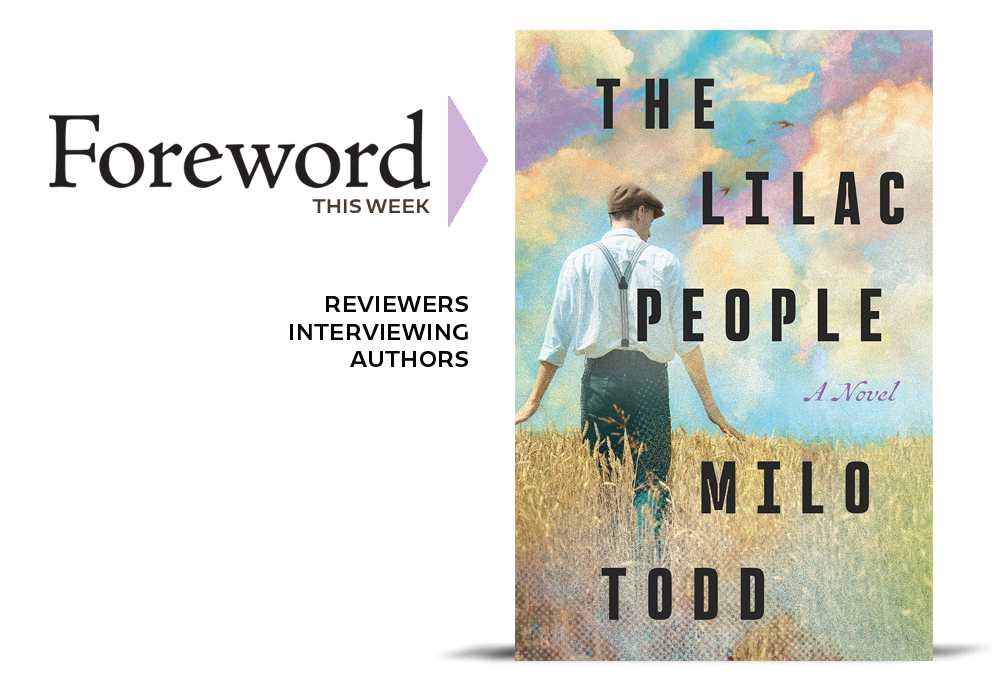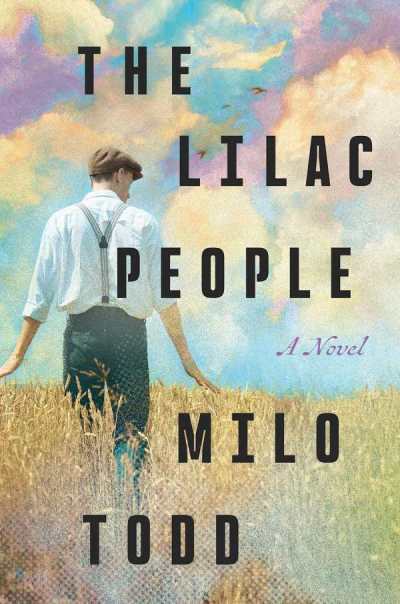Reviewer Isabella Zhou Interviews Milo Todd, Author of The Lilac People

Lots of years around books has taught us a few things about writers. To whit: pay attention when an author says something along the lines of, “it was important to me to write this story.”
Most often, that tell signifies an extremely personal, almost obligatory calling to write about a sensitive topic—in essence, it’s their attempt to right a wrong.
And yes, that fits the bill for today’s guest, Milo Todd, except that any normal person would have looked at the daunting task and discovered three compelling reasons not to write The Lilac People: 1) the research required that he teach himself German, 2) the existing primary sources related to queer life in Weimar Germany were suppressed over the years and grueling to locate, and 3) the subject matter was heartwrenching for him.
“It was tough, easily the most challenging book I’ve ever written or researched. … [but] It was important to me … so I just kept going,” is how he sums up all those years of work.

Isabella Zhou’s starred review of The Lilac People appeared in the Debut Fiction feature of Foreword‘s May/June issue—she called the book “exuberant, nerve-wracking, and heart-wrenching.” This followup conversation gave her the opportunity to talk with Milo about queer-anthem songs under the Nazis, survivors’ guilt, and his recommendations for being part of today’s resistance movement.
Don’t forget digital subscriptions to Foreword are free.
I want to know more about the central musical motif of your story, “The Lilac Song,” which is also referenced by the title of your book. What is its overall significance to your characters and the world they inhabit and how did it influence your writing process? Did you have it in mind since the start of writing or was it something that wove its way in later on? Were there any other Queer anthems you considered featuring prominently?
“Das Lila Lied” (“The Lilac Song” or “The Lavender Song”) caught my eye early on in my research because it’s the first known documented queer anthem in the entire colonized world. I found out Weimar Berlin included numerous firsts for the queer and trans community, so “The Lilac Song” was originally intended to be one of several. Even after I sketched out the entire plot, scene by scene, “The Lilac Song” didn’t necessarily feature more prominently than the other elements, at least in my head.
But as I finally started to write and draft, I realized how significant this song was to my characters and how easily it fit into the book’s themes of community, joy, and resilience. Despite how much I plan my drafts, I never force it to go in one direction or another. If what I planned isn’t working like I’d imagined, I just let it go where it wants to go. “The Lilac People” wanted to take a bigger portion of the book and so it did. Who am I to get in its way?
What was your research process like for reconstructing 1930s and 40s Germany?
It was tough, easily the most challenging book I’ve ever written or researched. I dug deep into surviving primary sources related to queer life, many of which are at the Magnus Hirschfeld Museum in Berlin, which dedicates itself to preserving what remains of Dr. Magnus Hirschfeld’s documented existence and his former Institute of Sexual Science. Since these sources are in German, I had to learn German. (I can’t believe my past self decided this so casually, learning a new language on top of all the other work this book required. I’m still mad at him.) I also looked into the work of historians and scholars who wrote about relevant topics, which helped direct me to where I should look next for sources, especially in the earlier stages of the research process. I found myself in a two-fold struggle from beginning to end: Not only was the subject matter difficult to uncover, but the subject matter itself was difficult, too. It was important to me, though, so I just kept going.
Your book features a large cast ranging from completely fictional to drawing, to varying degrees, from real-life, historical figures. Who was your favorite character to portray and why?
This is a tough one to answer because I truly did love writing each character in this book. They each brought something unique to the writing experience for me. But if I had to choose, I’d go with Karl simply because I loved writing the bits about him and the chickens. It’s such a small part of the book and probably doesn’t even make up an entire page in total, but I loved the imagery.
I am interested in the villains in The Lilac People. Undeniably, the Nazis are completely morally deplorable, but your book does also explore how Americans, despite popular depictions of them as the victorious, big-good heroes triumphing over evil, were themselves also complicit in persecuting those in the Queer and transgender communities. History is rarely black and white, so how do you portray these nuances without lapsing into moral equivalence fallacies (ie, “there were bad people on both sides”)?
Morality and goodness are such complex concepts that philosophers still haven’t come to an agreement on what exactly these things mean or how innate they are (or aren’t) to the human condition. So I simply tried to present that messiness as is. Sometimes people do immoral things because they want to, sometimes because they have to, and sometimes because they think they’re actually doing a moral thing.
If nothing else, hopefully how I’ve tackled morality in the book encourages readers to reflect upon and discuss the topic. Instead of making a declarative statement such as, “There were bad people on both sides,” I instead turn it into, “What do you think?” I love encouraging critical thought.
What stood out to me was the intense survivors’ guilt that plague your book’s main character, Bertie, his regret that he didn’t do more to help save the lives of other transgender and Queer individuals like himself. What, if anything, do you think survivors of persecution owe to the fallen? Can you also speak a bit more about the contradictions tied to archival storytelling and record-keeping? Your characters, at multiple points, recognize that these do the absolutely necessary work of containing the stories, confirming the identities, and asserting the humanity of their own marginalized communities but also face the brutal truth that if they fall into the wrong, persecutory hands, they can become a death warrant.
These are great questions. And like the morality question, I try to show the messiness of everything and allow the reader space to sort it out in their own head. Trans representation, for example, is a double-edged sword. Trans representation isn’t an end goal, but rather a means to an end (that end being human rights). But when trans representation increases and there aren’t said laws in place yet (which required an increase in representation to begin with), then this leads to violence. It’s extra exposure with no protection. So I lay contradictions like these out in the story for readers to absorb.
The same goes for what survivors owe the fallen. Bertie, Sofie, and Karl all deal with survivor’s guilt in their own way and from their own traumas, so I simply allow them to feel it and work through it in real time on the page. They grapple with such questions as what they might owe the fallen, how to live their lives moving forward, and whether they “deserved” to have survived. But ultimately, I let the reader take all that in for themselves. There are no easy answers and so I don’t provide any.
While reading The Lilac People, I was struck by parallels between the United States today and 1930s Germany. Both milieus, speaking in broad strokes, have seen cultures of perceived open-mindedness and social liberalism fall into reactionary fascism. What are effective means of resistance in the current political climate, where diversity is, unfortunately, being decried as a negative by certain powerful institutions?
It’s true there are some eerie parallels, though this book admittedly wasn’t intended to be timely. I started it years ago and it’s simply coincidence that it debuted when it did. I’m actually working on a free, virtual session that talks more about these parallels in depth and what to do, but for now I encourage people to 1) keep calm, 2) stay properly informed with sources that are reputable and that cite their work, and 3) engage in community support. I feel many folks these days think that if something isn’t big and loud then it isn’t worth doing. But support, assistance, and resistance are built on small gestures. Don’t underestimate the worth of a good deed or helping hand just because it feels so small. Small things are easier to do on a more regular basis, and enough people doing them on a regular basis turns those assistances into a new foundation of solidarity.
Can you give us a sneak peak at any projects you are currently working on that will be released in the near future?
As of this writing, I don’t have any other book offers since I haven’t offered them up since The Lilac People. All I’ll say for now is I have two former trans historical fiction books that I plan to give a fresh coat of paint and try to sell again, a new trans historical fiction that I plan to start researching soon, and a nonfiction book about the history of gender nonconformity and its relative oppressions that’s in its rough draft phase.
Isabella Zhou
